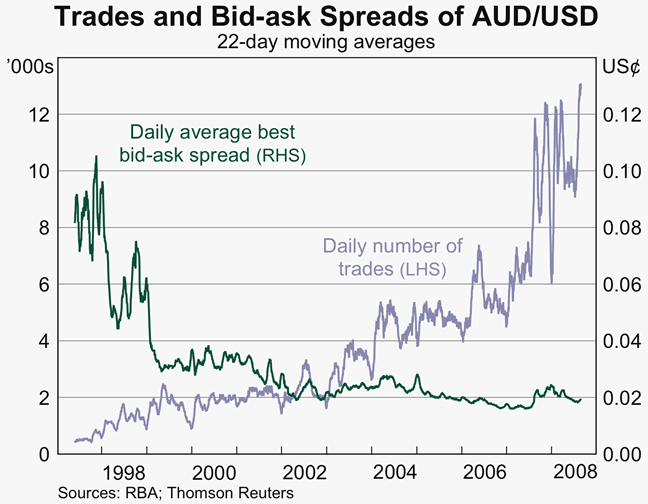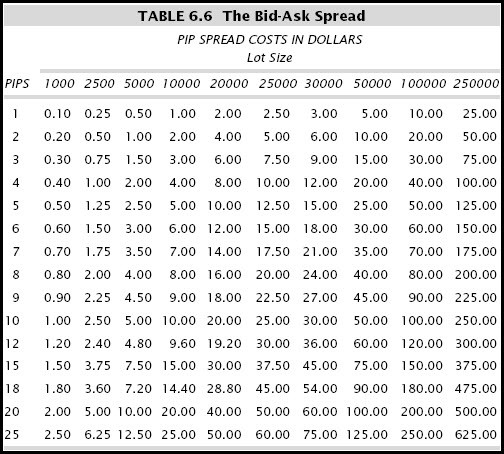How To Calculate The BidAsk Spread
Post on: 23 Июль, 2015 No Comment

The bid-ask spread is the difference between the bid price for a security and its ask (or offer) price. It represents the difference between the highest price that a buyer is willing to pay (bid) for a security and the lowest price that a seller is willing to accept for it. A transaction occurs either when a buyer accepts the ask price or a seller takes the bid price. In simple terms, a security will trend upward in price when buyers outnumber sellers, as the buyers bid the stock higher. Conversely, a security will trend lower in price when sellers outnumber buyers, as the supply-demand imbalance will force the sellers to lower their offer price. The bid-ask spread is an important consideration for most investors when trading securities, since it is a hidden cost incurred when trading any financial instrument – stocks, bonds, commodities. futures. options or foreign currency.
Spread Considerations
The following points need to be borne in mind with regard to bid-ask spreads:
- Spreads are determined by liquidity, as well as supply and demand for a specific security. The most liquid or widely traded securities tend to have the narrowest spreads, as long as there is no major imbalance between supply and demand. If there is a significant imbalance and lower liquidity, the bid-ask spread will expand substantially.
- Spreads on U.S. stocks have narrowed since the advent of “decimalization ” in 2001. Prior to that date, most U.S. stocks were quoted in fractions of 1/16 th of a dollar, of 6.25 cents. Most stocks now trade at bid-ask spreads well below that level.
- Bid-ask spreads represent a cost that is not always apparent to novice investors. While spread costs may be relatively insignificant for investors who do not trade frequently, they can represent a bigger cost for active traders who make numerous trades daily.
- Spreads widen during steep market declines because of the supply-demand imbalance as sellers “hit the bid” and buyers stay away in anticipation of lower prices. As a result, market makers widen the spread for two reasons: (1) to mitigate the higher risk of loss during volatile times, and (2) to dissuade investors from trading during such times, as a larger number of trades increases the risk to the market maker of being caught on the wrong side of the trade.
Examples of the Bid-Ask Spread
Example 1 . Consider a stock that is trading at $9.95 / $10. The bid price is $9.95 and the offer price is $10. The bid-ask spread in this case is 5 cents. The spread as a percentage is $0.05 / $10 or 0.50%.
A buyer who acquires the stock at $10 and immediately sells it at the bid price of $9.95 – either by accident or design – would incur a loss of 0.50% of the transaction value due to this spread. The purchase and immediate sale of 100 shares would entail a $5 loss, while if 10,000 shares were involved, the loss would be $500. The percentage loss resulting from the spread is the same in both cases.

Example 2 . Consider a retail forex trader who buys EUR 100,000 on margin. The current quote in the market is EUR 1 = USD 1.3300 / 1.3302.
The bid-ask spread in this case is 2 pips. The spread as a percentage is 0.015% (i.e. 0.0002 / 1.3302) of the traded amount of EUR 100,000.
Specifically with regard to forex spreads, take note of a few important caveats:
- Most forex trading at the retail level is done using a great deal of leverage. because of which spread costs as a percentage of the trader’s equity can be quite high. In the above example, assume the trader had equity of $5,000 in his or her account (which implies leverage of about 26.6:1 in this case). The $20 spread amounts to 0.4% of the trader’s margin in this instance.
- For a quick calculation of the cost of the spread as a percentage of your margin or equity, simply multiply the spread percentage by the degree of leverage. For example, if the spread in the above case was 5 pips (1.3300 / 1.3305), and the amount of leverage was 50:1, the cost of the spread as a percentage of the margin deposit is as much as 1.879% (0.0376% x 50).
- Spread costs can add up quickly in the rapid-fire world of forex trading, where traders’ holding period or investment horizon is typically much shorter than in stock trading.
Example 3 . Consider the example of an equity option trade. Let’s say you buy a short-term call option on stock XYZ as you are bullish on it. The stock is trading at $31.39 / $31.40, and the one-month $32 calls are trading at $0.72 / $0.73. The bid-ask spread in this case is just a penny, but in percentage terms, it’s a sizeable 1.37%.
The underlying stock is also trading with a penny spread, but in percentage terms the spread is much smaller at 0.032% because of the higher price of the stock as compared to the option.
An option trader, however, is unlikely to be deterred by the significantly higher spread percentage on the call, since the main motivation for buying a call option is to participate in the underlying stock’s advance while putting down a fraction of the amount required to buy the stock outright.
Bid-Ask Spread Tips
- Use limit orders . An investor or trader is generally better off using limit orders. which allow one to place a price limit for the purchase or sale of a security, rather than market orders. which are filled at the prevailing market price. In fast-moving markets, the use of market orders can result in a higher price than desired for purchases and a lower price for sales. For example, if the prevailing price of a security that you wish to buy is $9.95 / $10, rather than buying the stock at $10 you could consider bidding $9.97 for it. While the possibility of getting the stock 3 cents cheaper is offset by the risk that the stock may move up in price, you can always change your bid price if required. At least you will not be buying the stock at $10.05 because you entered a market order and the stock moved up in the interim.
- Avoid liquidity charges . The use of limit orders also enhances liquidity in the marketplace. This enables you to avoid the liquidity charges imposed by most electronic communication networks (ECNs) for using up market liquidity, which occurs when you use market orders executed at the prevailing bid and ask prices.
- Evaluate spread percentages . As the example earlier demonstrates, bid-ask spreads can be quite significant if you are using margin or leverage. Evaluate the spread percentage, since a 5-cent spread on a $10 stock is much greater in percentage terms than a 5-cent spread on a $40 stock.
- Shop around for the narrowest spreads . This is especially applicable to retail forex traders. who may not have the luxury of the 1-cent spreads available to interbank and institutional forex traders. Shop around for the narrowest spreads among the many forex brokers who specialize in retail clientele to improve your odds of trading success.
Conclusion
Pay attention to the bid-ask spread, since it is a hidden cost incurred in trading any financial instrument. Wide bid-ask spreads can also erode trading profits and aggravate losses. The impact of bid-ask spreads can be mitigated by using limit orders, evaluating spread percentages and shopping around for the narrowest spreads.














